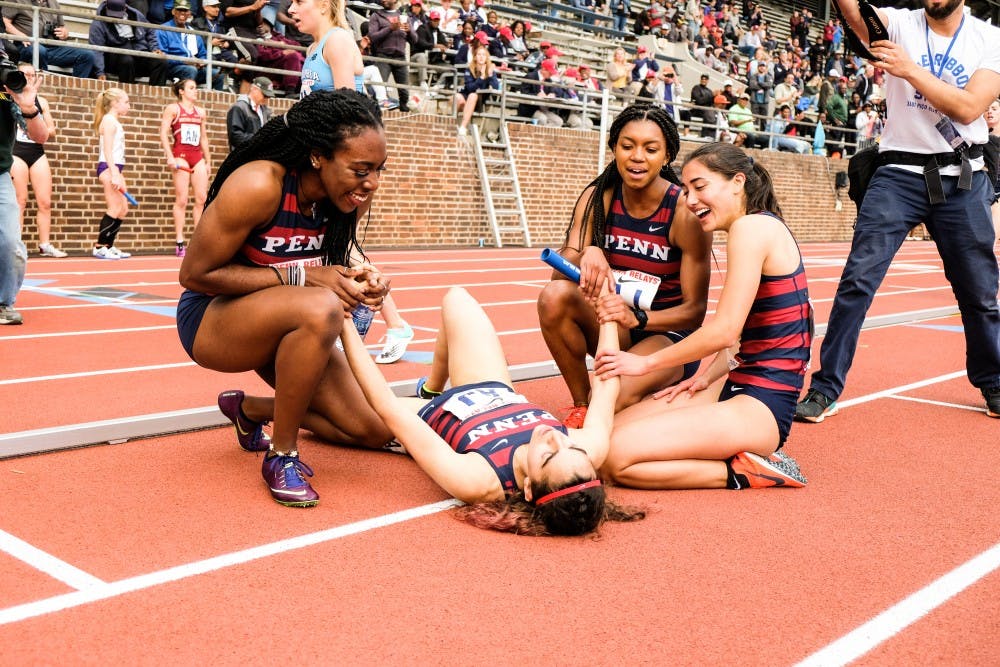
Famous athletes who have run at the Relays include Wilma Rudolph, Bob Beamon, Edwin Moses, Joan Benoit Samuelson, and Marion Jones.
Credit: Son NguyenThough adapted for different use over the years, Franklin Field always has been and always will be about one thing: track and field.
Built in 1895 and inaugurated by the first Penn Relays, known at the time as the Penn Carnival, the site has undergone countless transformations as the Relays have grown into an increasingly prominent event in the world of track and field.
The first Relays would see Penn and Harvard face off, with the Crimson ultimately stealing the first ever championship title in the 4x440 yard relay. From the first year, with only 9 events, the Relays rapidly expanded into an international affair, when only 19 years later, a team from Oxford University traveled to the United States by boat to compete and ultimately win the 1914 4-mile relay.
The rapid expansion didn’t stop there.
The Relays quickly became a pitstop on the path to greatness for many running hall-of-famers. A particularly significant moment in Franklin Field history occurred in 1936 in the months leading up to the famous Olympic games in Berlin.
Jesse Owens represented Ohio State at the Penn Relays, winning three separate events. Later that year, he would win four Olympic gold medals, a remarkable event of huge significance for United States strength against Nazi Germany in World War II.
Roger Bannister, the famous British mile runner, ran the Ben Franklin Mile at the Penn Relays in 1951 with a record time of 4:08.3. He would go on to become the first man to run a sub four minute mile.
Other famous athletes who have run at the Relays include Wilma Rudolph, Bob Beamon, Edwin Moses, Joan Benoit Samuelson, and Marion Jones. Most recently, Usain Bolt ran the 4x100 relay for Jamaica in 2010 as part of the USA vs. the world event, which was added in 2000 to expand the meet’s international presence.
Although there has been a significant presence from male competitors since the meet’s inception, the women would not race at Franklin Field until much later.
In 1962, on the 68th iteration of the meet, an event for women was finally added. The inaugural event was the 100-yard dash, and only nine women were invited to compete. Among them was Willye White, a hall of fame female athlete who competed and medaled in every Olympics from 1956 to 1972. White won the event, clocking 10.9 seconds to cement the gold medal standard of women competitors at the Relays.
Shortly thereafter, in 1967, Franklin Field finally abandoned the use of cinder, mud, and dust, installing the $200,000 synthetic track that is used today.
The newly installed track would continue to be grazed by competitors who go on to live extraordinary lives beyond athletics. Among them are Buzz Aldrin, Sean “P.Diddy” Combs, Luke Wilson, and even Bernie Sanders.
Franklin Field has seen 125 years of an event that stands for more than just athletics. The spirit of the Relays has become ingrained in people’s lives here in Philadelphia, and beyond.
John Haines, a class of ‘56 Penn graduate, won the 100 yard dash in 1956 and held the all time record of 9.6 seconds for three years before it was broken in 1959. The Penn relays made such a profound impact on his life that after finding great success as an athlete for 8 years, he transitioned to officiating, a role he has had with the meet for 53 years now.
He recalls experiencing over 60 years of Relays at Franklin Field.
“I’ve seen great baton passes, I’ve seen lousy ones. I’ve seen people drop them. It’s been a huge part of my life, and if it wasn’t I wouldn’t keep officiating. It becomes a part of you.”
The Daily Pennsylvanian is an independent, student-run newspaper. Please consider making a donation to support the coverage that shapes the University. Your generosity ensures a future of strong journalism at Penn.
Donate






